It can be difficult when starting out on a new predictive modeling project with neural networks.
There is so much to configure, and no clear idea where to start.
It is important to be systematic. You can break bad assumptions and quickly hone in on configurations that work and areas for further investigation likely to payoff.
In this tutorial, you will discover how to use exploratory configuration of multilayer perceptron (MLP) neural networks to find good first-cut models for time series forecasting.
After completing this tutorial, you will know:
- How to design a robust experimental test harness to evaluate MLP models for time series forecasting.
- Systematic experimental designs for varying epochs, neurons, and lag configurations.
- How to interpret results and use diagnostics to learn more about well-performing models.
Kick-start your project with my new book Deep Learning for Time Series Forecasting, including step-by-step tutorials and the Python source code files for all examples.
Let’s get started.
- Updated Jul/2017: Changed function for creating models to be more descriptive.
- Updated Apr/2019: Updated the link to dataset.

Exploratory Configuration of a Multilayer Perceptron Network for Time Series Forecasting
Photo by Lachlan Donald, some rights reserved.
Tutorial Overview
This tutorial is broken down into 6 parts. They are:
- Shampoo Sales Dataset
- Experimental Test Harness
- Vary Training Epochs
- Vary Hidden Layer Neurons
- Vary Hidden Layer Neurons with Lag
- Review of Results
Environment
This tutorial assumes you have a Python SciPy environment installed. You can use either Python 2 or 3 with this example.
This tutorial assumes you have Keras v2.0 or higher installed with either the TensorFlow or Theano backend.
This tutorial also assumes you have scikit-learn, Pandas, NumPy, and Matplotlib installed.
Next, let’s take a look at a standard time series forecasting problem that we can use as context for this experiment.
If you need help setting up your Python environment, see this post:
Shampoo Sales Dataset
This dataset describes the monthly number of sales of shampoo over a 3-year period.
The units are a sales count and there are 36 observations. The original dataset is credited to Makridakis, Wheelwright, and Hyndman (1998).
The example below loads and creates a plot of the loaded dataset.
|
1 2 3 4 5 6 7 8 9 10 11 12 13 |
# load and plot dataset from pandas import read_csv from pandas import datetime from matplotlib import pyplot # load dataset def parser(x): return datetime.strptime('190'+x, '%Y-%m') series = read_csv('shampoo-sales.csv', header=0, parse_dates=[0], index_col=0, squeeze=True, date_parser=parser) # summarize first few rows print(series.head()) # line plot series.plot() pyplot.show() |
Running the example loads the dataset as a Pandas Series and prints the first 5 rows.
|
1 2 3 4 5 6 7 |
Month 1901-01-01 266.0 1901-02-01 145.9 1901-03-01 183.1 1901-04-01 119.3 1901-05-01 180.3 Name: Sales, dtype: float64 |
A line plot of the series is then created showing a clear increasing trend.

Line Plot of Shampoo Sales Dataset
Next, we will take a look at the model configuration and test harness used in the experiment.
Experimental Test Harness
This section describes the test harness used in this tutorial.
Data Split
We will split the Shampoo Sales dataset into two parts: a training and a test set.
The first two years of data will be taken for the training dataset and the remaining one year of data will be used for the test set.
Models will be developed using the training dataset and will make predictions on the test dataset.
The persistence forecast (naive forecast) on the test dataset achieves an error of 136.761 monthly shampoo sales. This provides a lower acceptable bound of performance on the test set.
Model Evaluation
A rolling-forecast scenario will be used, also called walk-forward model validation.
Each time step of the test dataset will be walked one at a time. A model will be used to make a forecast for the time step, then the actual expected value from the test set will be taken and made available to the model for the forecast on the next time step.
This mimics a real-world scenario where new Shampoo Sales observations would be available each month and used in the forecasting of the following month.
This will be simulated by the structure of the train and test datasets.
All forecasts on the test dataset will be collected and an error score calculated to summarize the skill of the model. The root mean squared error (RMSE) will be used as it punishes large errors and results in a score that is in the same units as the forecast data, namely monthly shampoo sales.
Data Preparation
Before we can fit an MLP model to the dataset, we must transform the data.
The following three data transforms are performed on the dataset prior to fitting a model and making a forecast.
- Transform the time series data so that it is stationary. Specifically, a lag=1 differencing to remove the increasing trend in the data.
- Transform the time series into a supervised learning problem. Specifically, the organization of data into input and output patterns where the observation at the previous time step is used as an input to forecast the observation at the current timestep
- Transform the observations to have a specific scale. Specifically, to rescale the data to values between -1 and 1.
These transforms are inverted on forecasts to return them into their original scale before calculating and error score.
MLP Model
We will use a base MLP model with 1 neuron hidden layer, a rectified linear activation function on hidden neurons, and linear activation function on output neurons.
A batch size of 4 is used where possible, with the training data truncated to ensure the number of patterns is divisible by 4. In some cases a batch size of 2 is used.
Normally, the training dataset is shuffled after each batch or each epoch, which can aid in fitting the training dataset on classification and regression problems. Shuffling was turned off for all experiments as it seemed to result in better performance. More studies are needed to confirm this result for time series forecasting.
The model will be fit using the efficient ADAM optimization algorithm and the mean squared error loss function.
Experimental Runs
Each experimental scenario will be run 30 times and the RMSE score on the test set will be recorded from the end each run.
Let’s dive into the experiments.
Need help with Deep Learning for Time Series?
Take my free 7-day email crash course now (with sample code).
Click to sign-up and also get a free PDF Ebook version of the course.
Vary Training Epochs
In this first experiment, we will investigate varying the number of training epochs for a simple MLP with one hidden layer and one neuron in the hidden layer.
We will use a batch size of 4 and evaluate training epochs 50, 100, 500, 1000, and 2000.
The complete code listing is provided below.
This code listing will be used as the basis for all following experiments, with only the changes to this code provided in subsequent sections.
|
1 2 3 4 5 6 7 8 9 10 11 12 13 14 15 16 17 18 19 20 21 22 23 24 25 26 27 28 29 30 31 32 33 34 35 36 37 38 39 40 41 42 43 44 45 46 47 48 49 50 51 52 53 54 55 56 57 58 59 60 61 62 63 64 65 66 67 68 69 70 71 72 73 74 75 76 77 78 79 80 81 82 83 84 85 86 87 88 89 90 91 92 93 94 95 96 97 98 99 100 101 102 103 104 105 106 107 108 109 110 111 112 113 114 115 116 117 118 119 120 121 122 123 124 125 |
from pandas import DataFrame from pandas import Series from pandas import concat from pandas import read_csv from pandas import datetime from sklearn.metrics import mean_squared_error from sklearn.preprocessing import MinMaxScaler from keras.models import Sequential from keras.layers import Dense from math import sqrt import matplotlib # be able to save images on server matplotlib.use('Agg') from matplotlib import pyplot import numpy # date-time parsing function for loading the dataset def parser(x): return datetime.strptime('190'+x, '%Y-%m') # frame a sequence as a supervised learning problem def timeseries_to_supervised(data, lag=1): df = DataFrame(data) columns = [df.shift(i) for i in range(1, lag+1)] columns.append(df) df = concat(columns, axis=1) return df # create a differenced series def difference(dataset, interval=1): diff = list() for i in range(interval, len(dataset)): value = dataset[i] - dataset[i - interval] diff.append(value) return Series(diff) # invert differenced value def inverse_difference(history, yhat, interval=1): return yhat + history[-interval] # scale train and test data to [-1, 1] def scale(train, test): # fit scaler scaler = MinMaxScaler(feature_range=(-1, 1)) scaler = scaler.fit(train) # transform train train = train.reshape(train.shape[0], train.shape[1]) train_scaled = scaler.transform(train) # transform test test = test.reshape(test.shape[0], test.shape[1]) test_scaled = scaler.transform(test) return scaler, train_scaled, test_scaled # inverse scaling for a forecasted value def invert_scale(scaler, X, yhat): new_row = [x for x in X] + [yhat] array = numpy.array(new_row) array = array.reshape(1, len(array)) inverted = scaler.inverse_transform(array) return inverted[0, -1] # fit an MLP network to training data def fit_model(train, batch_size, nb_epoch, neurons): X, y = train[:, 0:-1], train[:, -1] model = Sequential() model.add(Dense(neurons, activation='relu', input_dim=X.shape[1])) model.add(Dense(1)) model.compile(loss='mean_squared_error', optimizer='adam') model.fit(X, y, epochs=nb_epoch, batch_size=batch_size, verbose=0, shuffle=False) return model # run a repeated experiment def experiment(repeats, series, epochs, lag, neurons): # transform data to be stationary raw_values = series.values diff_values = difference(raw_values, 1) # transform data to be supervised learning supervised = timeseries_to_supervised(diff_values, lag) supervised_values = supervised.values[lag:,:] # split data into train and test-sets train, test = supervised_values[0:-12], supervised_values[-12:] # transform the scale of the data scaler, train_scaled, test_scaled = scale(train, test) # run experiment error_scores = list() for r in range(repeats): # fit the model batch_size = 4 train_trimmed = train_scaled[2:, :] model = fit_model(train_trimmed, batch_size, epochs, neurons) # forecast test dataset test_reshaped = test_scaled[:,0:-1] output = model.predict(test_reshaped, batch_size=batch_size) predictions = list() for i in range(len(output)): yhat = output[i,0] X = test_scaled[i, 0:-1] # invert scaling yhat = invert_scale(scaler, X, yhat) # invert differencing yhat = inverse_difference(raw_values, yhat, len(test_scaled)+1-i) # store forecast predictions.append(yhat) # report performance rmse = sqrt(mean_squared_error(raw_values[-12:], predictions)) print('%d) Test RMSE: %.3f' % (r+1, rmse)) error_scores.append(rmse) return error_scores # load dataset series = read_csv('shampoo-sales.csv', header=0, parse_dates=[0], index_col=0, squeeze=True, date_parser=parser) # experiment repeats = 30 results = DataFrame() lag = 1 neurons = 1 # vary training epochs epochs = [50, 100, 500, 1000, 2000] for e in epochs: results[str(e)] = experiment(repeats, series, e, lag, neurons) # summarize results print(results.describe()) # save boxplot results.boxplot() pyplot.savefig('boxplot_epochs.png') |
Running the experiment prints the test set RMSE at the end of each experimental run.
At the end of all runs, a table of summary statistics is provided, one row for each statistic and one configuration for each column.
Note: Your results may vary given the stochastic nature of the algorithm or evaluation procedure, or differences in numerical precision. Consider running the example a few times and compare the average outcome.
The summary statistics suggest that on average 1000 training epochs resulted in the better performance with a general decreasing trend in error with the increase of training epochs.
|
1 2 3 4 5 6 7 8 9 |
50 100 500 1000 2000 count 30.000000 30.000000 30.000000 30.000000 30.000000 mean 129.660167 129.388944 111.444027 103.821703 107.500301 std 30.926344 28.499592 23.181317 22.138705 24.780781 min 94.598957 94.184903 89.506815 86.511801 86.452041 25% 105.198414 105.722736 90.679930 90.058655 86.457260 50% 129.705407 127.449491 93.508245 90.118331 90.074494 75% 141.420145 149.625816 136.157299 135.510850 135.741340 max 198.716220 198.704352 141.226816 139.994388 142.097747 |
A box and whisker plot of the distribution of test RMSE scores for each configuration was also created and saved to file.
The plot highlights that each configuration shows the same general spread in test RMSE scores (box), with the median (green line) trending downward with the increase of training epochs.
The results confirm that the configured MLP trained for 1000 is a good starting point on this problem.
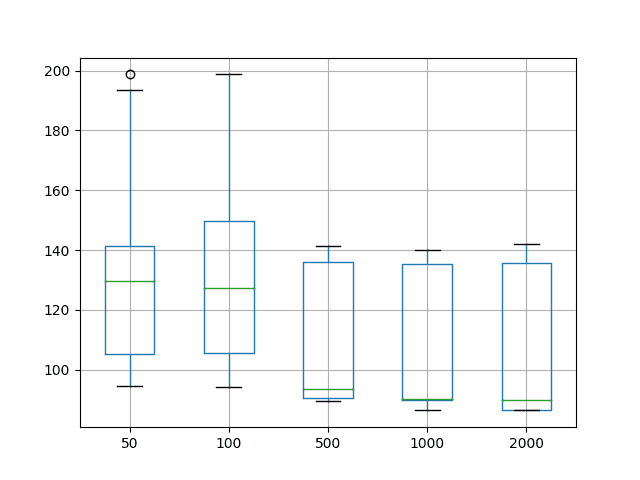
Box and Whisker Plot of Varying Training Epochs for Time Series Forecasting on the Shampoo Sales Dataset
Another angle to consider with a network configuration is how it behaves over time as the model is being fit.
We can evaluate the model on the training and test datasets after each training epoch to get an idea as to if the configuration is overfitting or underfitting the problem.
We will use this diagnostic approach on the top result from each set of experiments. A total of 10 repeats of the configuration will be run and the train and test RMSE scores after each training epoch plotted on a line plot.
In this case, we will use this diagnostic on the MLP fit for 1000 epochs.
The complete diagnostic code listing is provided below.
As with the previous code listing, the code listing below will be used as the basis for all diagnostics in this tutorial and only the changes to this listing will be provided in subsequent sections.
|
1 2 3 4 5 6 7 8 9 10 11 12 13 14 15 16 17 18 19 20 21 22 23 24 25 26 27 28 29 30 31 32 33 34 35 36 37 38 39 40 41 42 43 44 45 46 47 48 49 50 51 52 53 54 55 56 57 58 59 60 61 62 63 64 65 66 67 68 69 70 71 72 73 74 75 76 77 78 79 80 81 82 83 84 85 86 87 88 89 90 91 92 93 94 95 96 97 98 99 100 101 102 103 104 105 106 107 108 109 110 111 112 113 114 115 116 117 118 119 120 121 122 123 124 125 126 127 128 129 130 131 132 |
from pandas import DataFrame from pandas import Series from pandas import concat from pandas import read_csv from pandas import datetime from sklearn.metrics import mean_squared_error from sklearn.preprocessing import MinMaxScaler from keras.models import Sequential from keras.layers import Dense from math import sqrt import matplotlib # be able to save images on server matplotlib.use('Agg') from matplotlib import pyplot import numpy # date-time parsing function for loading the dataset def parser(x): return datetime.strptime('190'+x, '%Y-%m') # frame a sequence as a supervised learning problem def timeseries_to_supervised(data, lag=1): df = DataFrame(data) columns = [df.shift(i) for i in range(1, lag+1)] columns.append(df) df = concat(columns, axis=1) df = df.drop(0) return df # create a differenced series def difference(dataset, interval=1): diff = list() for i in range(interval, len(dataset)): value = dataset[i] - dataset[i - interval] diff.append(value) return Series(diff) # scale train and test data to [-1, 1] def scale(train, test): # fit scaler scaler = MinMaxScaler(feature_range=(-1, 1)) scaler = scaler.fit(train) # transform train train = train.reshape(train.shape[0], train.shape[1]) train_scaled = scaler.transform(train) # transform test test = test.reshape(test.shape[0], test.shape[1]) test_scaled = scaler.transform(test) return scaler, train_scaled, test_scaled # inverse scaling for a forecasted value def invert_scale(scaler, X, yhat): new_row = [x for x in X] + [yhat] array = numpy.array(new_row) array = array.reshape(1, len(array)) inverted = scaler.inverse_transform(array) return inverted[0, -1] # evaluate the model on a dataset, returns RMSE in transformed units def evaluate(model, raw_data, scaled_dataset, scaler, offset, batch_size): # separate X, y = scaled_dataset[:,0:-1], scaled_dataset[:,-1] # forecast dataset output = model.predict(X, batch_size=batch_size) # invert data transforms on forecast predictions = list() for i in range(len(output)): yhat = output[i,0] # invert scaling yhat = invert_scale(scaler, X[i], yhat) # invert differencing yhat = yhat + raw_data[i] # store forecast predictions.append(yhat) # report performance rmse = sqrt(mean_squared_error(raw_data[1:], predictions)) return rmse # fit an MLP network to training data def fit(train, test, raw, scaler, batch_size, nb_epoch, neurons): X, y = train[:, 0:-1], train[:, -1] # prepare model model = Sequential() model.add(Dense(neurons, activation='relu', input_dim=X.shape[1])) model.add(Dense(1)) model.compile(loss='mean_squared_error', optimizer='adam') # fit model train_rmse, test_rmse = list(), list() for i in range(nb_epoch): model.fit(X, y, epochs=1, batch_size=batch_size, verbose=0, shuffle=False) # evaluate model on train data raw_train = raw[-(len(train)+len(test)+1):-len(test)] train_rmse.append(evaluate(model, raw_train, train, scaler, 0, batch_size)) # evaluate model on test data raw_test = raw[-(len(test)+1):] test_rmse.append(evaluate(model, raw_test, test, scaler, 0, batch_size)) history = DataFrame() history['train'], history['test'] = train_rmse, test_rmse return history # run diagnostic experiments def run(): # config repeats = 10 n_batch = 4 n_epochs = 1000 n_neurons = 1 n_lag = 1 # load dataset series = read_csv('shampoo-sales.csv', header=0, parse_dates=[0], index_col=0, squeeze=True, date_parser=parser) # transform data to be stationary raw_values = series.values diff_values = difference(raw_values, 1) # transform data to be supervised learning supervised = timeseries_to_supervised(diff_values, n_lag) supervised_values = supervised.values[n_lag:,:] # split data into train and test-sets train, test = supervised_values[0:-12], supervised_values[-12:] # transform the scale of the data scaler, train_scaled, test_scaled = scale(train, test) # fit and evaluate model train_trimmed = train_scaled[2:, :] # run diagnostic tests for i in range(repeats): history = fit(train_trimmed, test_scaled, raw_values, scaler, n_batch, n_epochs, n_neurons) pyplot.plot(history['train'], color='blue') pyplot.plot(history['test'], color='orange') print('%d) TrainRMSE=%f, TestRMSE=%f' % (i, history['train'].iloc[-1], history['test'].iloc[-1])) pyplot.savefig('diagnostic_epochs.png') # entry point run() |
Running the diagnostic prints the final train and test RMSE for each run. More interesting is the final line plot created.
The line plot shows the train RMSE (blue) and test RMSE (orange) after each training epoch.
In this case, the diagnostic plot shows little difference in train and test RMSE after about 400 training epochs. Both train and test performance level out on a near flat line.
This rapid leveling out suggests the model is reaching capacity and may benefit from more information in terms of lag observations or additional neurons.
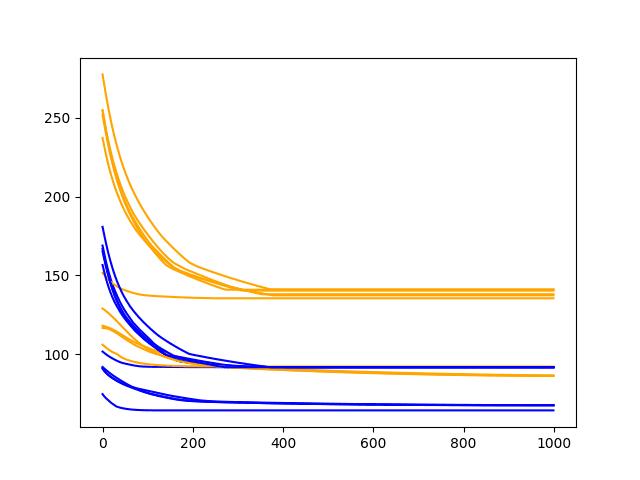
Diagnostic Line Plot of Train and Test Performance of 1000 Epochs on the Shampoo Sales Dataset
Vary Hidden Layer Neurons
In this section, we will look at varying the number of neurons in the single hidden layer.
Increasing the number of neurons can increase the learning capacity of the network at the risk of overfitting the training data.
We will explore increasing the number of neurons from 1 to 5 and fit the network for 1000 epochs.
The differences in the experiment script are listed below.
|
1 2 3 4 5 6 7 8 9 10 11 12 13 14 15 16 |
# load dataset series = read_csv('shampoo-sales.csv', header=0, parse_dates=[0], index_col=0, squeeze=True, date_parser=parser) # experiment repeats = 30 results = DataFrame() lag = 1 epochs = 1000 # vary neurons neurons = [1, 2, 3, 4, 5] for n in neurons: results[str(n)] = experiment(repeats, series, epochs, lag, n) # summarize results print(results.describe()) # save boxplot results.boxplot() pyplot.savefig('boxplot_neurons.png') |
Running the experiment prints summary statistics for each configuration.
Note: Your results may vary given the stochastic nature of the algorithm or evaluation procedure, or differences in numerical precision. Consider running the example a few times and compare the average outcome.
Looking at the average performance, it suggests a decrease of test RMSE with an increase in the number of neurons in the single hidden layer.
The best results appear to be with 3 neurons.
|
1 2 3 4 5 6 7 8 9 |
1 2 3 4 5 count 30.000000 30.000000 30.000000 30.000000 30.000000 mean 105.107026 102.836520 92.675912 94.889952 96.577617 std 23.130824 20.102353 10.266732 9.751318 6.421356 min 86.565630 84.199871 83.388967 84.385293 87.208454 25% 88.035396 89.386670 87.643954 89.154866 89.961809 50% 90.084895 91.488484 90.670565 91.204303 96.717739 75% 136.145248 104.416518 93.117926 100.228730 101.969331 max 143.428154 140.923087 136.883946 135.891663 106.797563 |
A box and whisker plot is also created to summarize and compare the distributions of results.
The plot confirms the suggestion of 3 neurons performing well compared to the other configurations and suggests in addition that the spread of results is also smaller. This may indicate a more stable configuration.

Box and Whisker Plot of Varying Hidden Neurons for Time Series Forecasting on the Shampoo Sales Dataset
Again, we can dive a little deeper by reviewing diagnostics of the chosen configuration of 3 neurons fit for 1000 epochs.
The changes to the diagnostic script are limited to the run() function and listed below.
|
1 2 3 4 5 6 7 8 9 10 11 12 13 14 15 16 17 18 19 20 21 22 23 24 25 26 27 28 29 |
# run diagnostic experiments def run(): # config repeats = 10 n_batch = 4 n_epochs = 1000 n_neurons = 3 n_lag = 1 # load dataset series = read_csv('shampoo-sales.csv', header=0, parse_dates=[0], index_col=0, squeeze=True, date_parser=parser) # transform data to be stationary raw_values = series.values diff_values = difference(raw_values, 1) # transform data to be supervised learning supervised = timeseries_to_supervised(diff_values, n_lag) supervised_values = supervised.values[n_lag:,:] # split data into train and test-sets train, test = supervised_values[0:-12], supervised_values[-12:] # transform the scale of the data scaler, train_scaled, test_scaled = scale(train, test) # fit and evaluate model train_trimmed = train_scaled[2:, :] # run diagnostic tests for i in range(repeats): history = fit(train_trimmed, test_scaled, raw_values, scaler, n_batch, n_epochs, n_neurons) pyplot.plot(history['train'], color='blue') pyplot.plot(history['test'], color='orange') print('%d) TrainRMSE=%f, TestRMSE=%f' % (i, history['train'].iloc[-1], history['test'].iloc[-1])) pyplot.savefig('diagnostic_neurons.png') |
Running the diagnostic script provides a line plot of train and test RMSE for each training epoch.
The diagnostics suggest a flattening out of model skill, perhaps around 400 epochs. The plot also suggests a possible situation of overfitting where there is a slight increase in test RMSE over the last 500 training epochs, but not a strong increase in training RMSE.
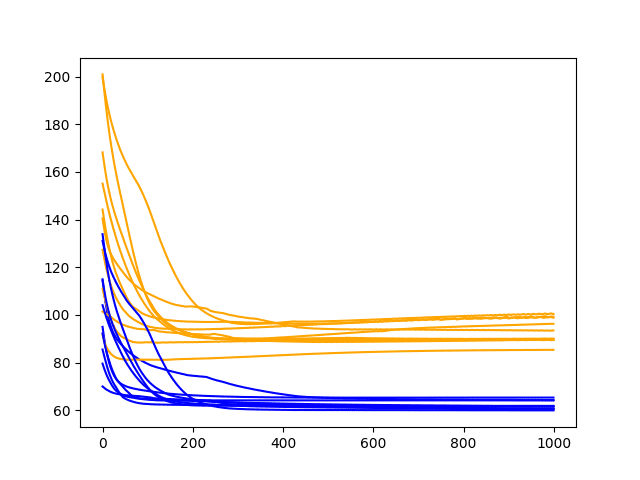
Diagnostic Line Plot of Train and Test Performance of 3 Hidden Neurons on the Shampoo Sales Dataset
Vary Hidden Layer Neurons with Lag
In this section, we will look at increasing the lag observations as input, whilst at the same time increasing the capacity of the network.
Increased lag observations will automatically scale the number of input neurons. For example, 3 lag observations as input will result in 3 input neurons.
The added input will require additional capacity in the network. As such, we will also scale the number of neurons in the one hidden layer with the number of lag observations used as input.
We will use odd numbers of lag observations as input from 1, 3, 5, and 7 and use the same number of neurons respectively.
The change to the number of inputs affects the total number of training patterns during the conversion of the time series data to a supervised learning problem. As such, the batch size was reduced from 4 to 2 for all experiments in this section.
A total of 1000 training epochs are used in each experimental run.
The changes from the base experiment script are limited to the experiment() function and the running of the experiment, listed below.
|
1 2 3 4 5 6 7 8 9 10 11 12 13 14 15 16 17 18 19 20 21 22 23 24 25 26 27 28 29 30 31 32 33 34 35 36 37 38 39 40 41 42 43 44 45 46 47 48 49 50 51 52 |
# run a repeated experiment def experiment(repeats, series, epochs, lag, neurons): # transform data to be stationary raw_values = series.values diff_values = difference(raw_values, 1) # transform data to be supervised learning supervised = timeseries_to_supervised(diff_values, lag) supervised_values = supervised.values[lag:,:] # split data into train and test-sets train, test = supervised_values[0:-12], supervised_values[-12:] # transform the scale of the data scaler, train_scaled, test_scaled = scale(train, test) # run experiment error_scores = list() for r in range(repeats): # fit the model batch_size = 2 model = fit_model(train_scaled, batch_size, epochs, neurons) # forecast test dataset test_reshaped = test_scaled[:,0:-1] output = model.predict(test_reshaped, batch_size=batch_size) predictions = list() for i in range(len(output)): yhat = output[i,0] X = test_scaled[i, 0:-1] # invert scaling yhat = invert_scale(scaler, X, yhat) # invert differencing yhat = inverse_difference(raw_values, yhat, len(test_scaled)+1-i) # store forecast predictions.append(yhat) # report performance rmse = sqrt(mean_squared_error(raw_values[-12:], predictions)) print('%d) Test RMSE: %.3f' % (r+1, rmse)) error_scores.append(rmse) return error_scores # load dataset series = read_csv('shampoo-sales.csv', header=0, parse_dates=[0], index_col=0, squeeze=True, date_parser=parser) # experiment repeats = 30 results = DataFrame() epochs = 1000 # vary neurons neurons = [1, 3, 5, 7] for n in neurons: results[str(n)] = experiment(repeats, series, epochs, n, n) # summarize results print(results.describe()) # save boxplot results.boxplot() pyplot.savefig('boxplot_neurons_lag.png') |
Running the experiment summarizes the results using descriptive statistics for each configuration.
Note: Your results may vary given the stochastic nature of the algorithm or evaluation procedure, or differences in numerical precision. Consider running the example a few times and compare the average outcome.
The results suggest that all increases in lag input variables with increases with hidden neurons decrease performance.
Of note is the 1 neuron and 1 input configuration, which compared to the results from the previous section resulted in a similar mean and standard deviation.
It is possible that the decrease in performance is related to the smaller batch size and that the results from the 1-neuron/1-lag case are insufficient to tease this out.
|
1 2 3 4 5 6 7 8 9 |
1 3 5 7 count 30.000000 30.000000 30.000000 30.000000 mean 105.465038 109.447044 158.894730 147.024776 std 20.827644 15.312300 43.177520 22.717514 min 89.909627 77.426294 88.515319 95.801699 25% 92.187690 102.233491 125.008917 132.335683 50% 92.587411 109.506480 166.438582 145.078842 75% 135.386125 118.635143 189.457325 166.329000 max 139.941789 144.700754 232.962778 186.185471 |
A box and whisker plot of the distribution of results was also created allowing configurations to be compared.
Interestingly, the use of 3 neurons and 3 input variables shows a tighter spread compared to the other configurations. This is similar to the observation from 3 neurons and 1 input variable seen in the previous section.

Box and Whisker Plot of Varying Lag Features and Hidden Neurons for Time Series Forecasting on the Shampoo Sales Dataset
We can also use diagnostics to tease out how the dynamics of the model might have changed while fitting the model.
The results for 3-lags/3-neurons are interesting and we will investigate them further.
The changes to the diagnostic script are confined to the run() function.
|
1 2 3 4 5 6 7 8 9 10 11 12 13 14 15 16 17 18 19 20 21 22 23 24 25 26 27 28 29 |
# run diagnostic experiments def run(): # config repeats = 10 n_batch = 2 n_epochs = 1000 n_neurons = 3 n_lag = 3 # load dataset series = read_csv('shampoo-sales.csv', header=0, parse_dates=[0], index_col=0, squeeze=True, date_parser=parser) # transform data to be stationary raw_values = series.values diff_values = difference(raw_values, 1) # transform data to be supervised learning supervised = timeseries_to_supervised(diff_values, n_lag) supervised_values = supervised.values[n_lag:,:] # split data into train and test-sets train, test = supervised_values[0:-12], supervised_values[-12:] # transform the scale of the data scaler, train_scaled, test_scaled = scale(train, test) # fit and evaluate model train_trimmed = train_scaled[2:, :] # run diagnostic tests for i in range(repeats): history = fit(train_trimmed, test_scaled, raw_values, scaler, n_batch, n_epochs, n_neurons) pyplot.plot(history['train'], color='blue') pyplot.plot(history['test'], color='orange') print('%d) TrainRMSE=%f, TestRMSE=%f' % (i, history['train'].iloc[-1], history['test'].iloc[-1])) pyplot.savefig('diagnostic_neurons_lag.png') |
Running the diagnostics script creates a line plot showing the train and test RMSE after each training epoch for 10 experimental runs.
The results suggest good learning during the first 500 epochs and perhaps overfitting in the remaining epochs with the test RMSE showing an increasing trend and the train RMSE showing a decreasing trend.
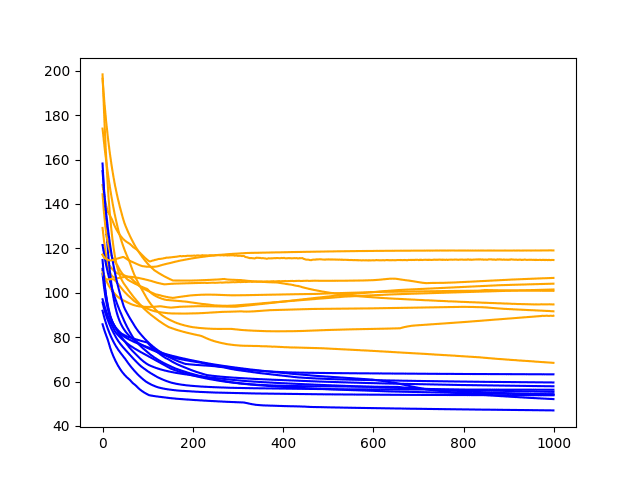
Diagnostic Line Plot of Train and Test Performance of 3 Hidden Neurons and Lag Features on the Shampoo Sales Dataset
Review of Results
We have covered a lot of ground in this tutorial. Let’s review.
- Epochs. We looked at how model skill varied with the number of training epochs and found that 1000 might be a good starting point.
- Neurons. We looked at varying the number of neurons in the hidden layer and found that 3 neurons might be a good configuration.
- Lag Inputs. We looked at varying the number of lag observations as inputs whilst at the same time increasing the number of neurons in the hidden layer and found that results generally got worse, but again, 3 neurons in the hidden layer shows interest. Poor results may have been related to the change of batch size from 4 to 2 compared to other experiments.
The results suggest using a 1 lag input, 3 neurons in the hidden layer, and fit for 1000 epochs as a first-cut model configuration.
This can be improved upon in many ways; the next section lists some ideas.
Extensions
This section lists extensions and follow-up experiments you might like to explore.
- Shuffle vs No Shuffle. No shuffling was used, which is abnormal. Develop an experiment to compare shuffling to no shuffling of the training set when fitting the model for time series forecasting.
- Normalization Method. Data was rescaled to -1 to 1, typical for a tanh activation function, not used in the model configurations. Explore other rescaling, such as 0-1 normalization and standardization and the impact on model performance.
- Multiple Layers. Explore the use of multiple hidden layers to add network capacity to learn more complex multi-step patterns.
- Feature Engineering. Explore the use of additional features, such as an error time series and even elements of the date-time of each observation.
Also, check out the post:
Did you try any of these extensions?
Post your results in the comments below.
Summary
In this tutorial, you discovered how to use systematic experiments to explore the configuration of a multilayer perceptron for time series forecasting and develop a first-cut model.
Specifically, you learned:
- How to develop a robust test harness for evaluating MLP models for time series forecasting.
- How to systematically evaluate training epochs, hidden layer neurons, and lag inputs.
- How to use diagnostics to help interpret results and suggest follow-up experiments.
Do you have any questions about this tutorial?
Ask your questions in the comments below and I will do my best to answer.

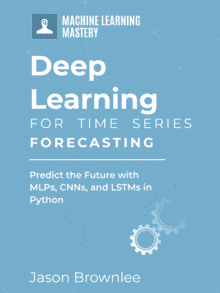
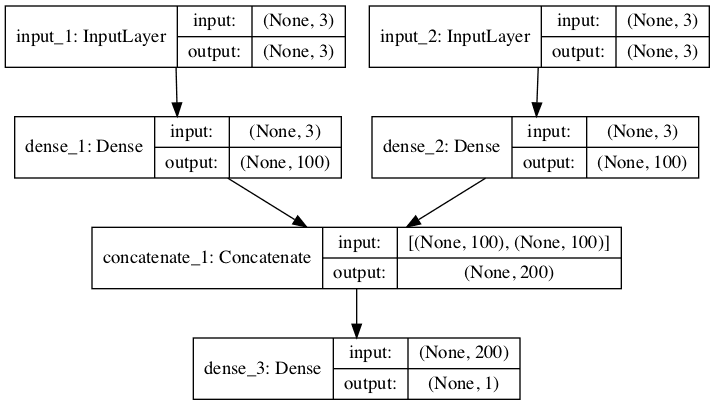



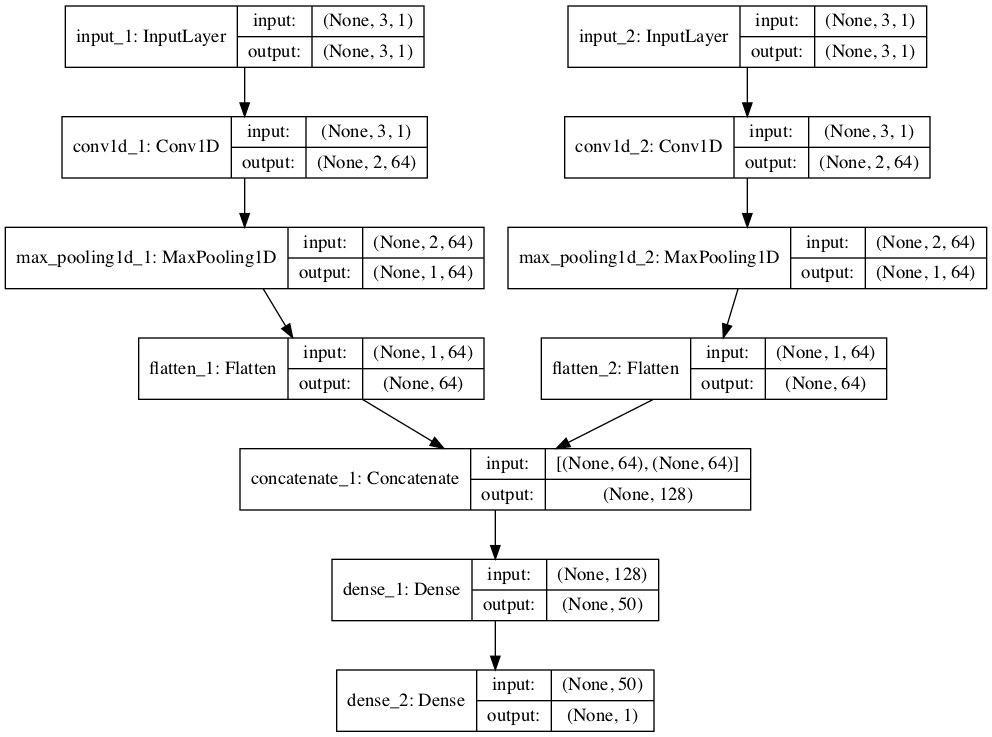

what is mean by transforming observations to have specific scale? can u more elaborate it with simple example?
Yes, normalize each column to the range 0-1.
Hi Jason,
I have a question regarding the prediction result evaluation.
In my code, I get MSE MAE MAPE calculated by keras as follows:
model.compile(loss=’mse’, optimizer=optimizer, metrics=[‘mae’, ‘mape’])
…
Epoch 150/150
0s – loss: 0.0038 – mean_absolute_error: 0.0455 – mean_absolute_percentage_error: 164095.5176
mse=0.003538, mae=0.043654, mape=58238.251235
————————————————————————-
But when I compute these values by the code:
mse = mean_squared_error(test_Y, predicted_output)
rmse = math.sqrt(mse)
mae = mean_absolute_error(test_Y, predicted_output)
mape = np.mean(np.abs(np.divide(np.subtract(test_Y, predicted_output), test_Y))) * 100
RMSE: 14.992
MAE: 10.462
MAPE: 2.208
The two results are very different from each other. What happened?
That is interesting. I’m not sure what is going on here.
I would trust the manual results. I have not had any issues like this myself, my epoch scores always seem to match my post-training evaluation.
Consider preparing a small self-contained example and posting it as a bug to the Keras project:
https://github.com/fchollet/keras
I give it a try on your example.
https://machinelearningmastery.com/time-series-prediction-lstm-recurrent-neural-networks-python-keras/
Change
model.compile(loss=’mean_squared_error’, optimizer=’adam’)
to
model.compile(loss=’mean_squared_error’, optimizer=’adam’, metrics=[‘mae’, ‘mape’])
Got the same result.
0s – loss: 0.0019 – mean_absolute_error: 0.0343 – mean_absolute_percentage_error: 620693.8651
Epoch 96/100
0s – loss: 0.0020 – mean_absolute_error: 0.0351 – mean_absolute_percentage_error: 326543.9207
Epoch 97/100
0s – loss: 0.0019 – mean_absolute_error: 0.0345 – mean_absolute_percentage_error: 488762.9108
Epoch 98/100
0s – loss: 0.0019 – mean_absolute_error: 0.0345 – mean_absolute_percentage_error: 514091.1566
Epoch 99/100
0s – loss: 0.0019 – mean_absolute_error: 0.0345 – mean_absolute_percentage_error: 531419.0410
Epoch 100/100
0s – loss: 0.0019 – mean_absolute_error: 0.0341 – mean_absolute_percentage_error: 454424.3737
Train Score: 22.34 RMSE
Test Score: 45.66 RMSE
What is the most robust sign for overfitting?
Skill on the test set is worse than the training set.
Is there a list of overfitting signs available?
Alternative:
If I want to prepare such a list, how should it look like?
1. Skill on the test set is worse than the training set.
2. ?
3. ?
4. ?
5. ?
Is there a function available for our code, which ‘alerts’ overfitting?
I monitor every result and multiple parameters of your examples in a Sqlite database.
Therefore I could easelly tagging overfitting.
For example if a test result is worse then the training set.
Could there be more relations of parameters and results to monitor for overfitting in general?
It is a trend you are seeking for overfitting, not necessarily one result being worse.
https://en.wikipedia.org/wiki/Overfitting
No.
Nope. The first is all you need.
Instead, you develop a list of 100s of ways to address overfitting/early convergence.
A)
Does “Skill on the test set is worse than the training set”
mean trainRmse is less then testRmse?
In my baseline-test my trainRmse is always zero and the testRmse is always higher? Is this normal?
B)
Could we say that a higher variance of test values is an indicator for overfitting?
This post might make things clearer for you Hans:
https://machinelearningmastery.com/overfitting-and-underfitting-with-machine-learning-algorithms/
Could we assume that the best performing epoches, neurons and lag inputs found with this MLP setup are also the best performing ones in a LSTM model or any other model?
No, generally findings are not transferable to other problems or other algorithms.
Is it possible to save a trained model on HD, to predict unseen data later, in a shorter time?
Would it be possible to achieve the same study using GridSearchCV, like you did in another post? Or is it not possible for time series?
No, we must use walk-forward validation to evaluate time series models correctly:
https://machinelearningmastery.com/backtest-machine-learning-models-time-series-forecasting/
Hi Jason,
Thanks for a great tutorial.
Could you give me an advice how to model, a multivariate timeseries with MLP. For example, if we model a timeseries such an energy consumption with window approach like in the example above. How do we add/model additional features such as dates, temperature, etc, which can be also timeseries?
Is the only option to create a single array with all the different timeseries one after another and hope that the network can learn their relations? If yes, it seems strange that there are no way to indicate which inputs relate to each other timewise… But I guess the LSTM and other RNN are just for this purpose…
You could try modeling each series with separate networks and ensemble the models, you could try one large model for all series, I’d encourage you to experiment and see what works best for your data.
Hi Jason,
Please do you have any example of this:
“You could try modeling each series with separate networks and ensemble the models…”
Could you please give more explanation of how we could combine the models to form an ensample?
In this case, any need for a final model? That is, fitting the ensembled model(s) with all available data?
No, sorry.
Hi Jason,
Thanks for the great tutorials you offer. I have both tried the LSTM examples and this MLP example. All these examples gave me good insights and helped me to configure models and do optimizations for my own data.
A characteristic of time series is that the predictions (forecasts) are based on history data. But in this MLP example I observed the testing data is used to make the predictions:
output = model.predict(test_reshaped, batch_size=batch_size)
I think this essentially is a matter of regression and not time series. The model can only predict values based on input values and the model is not able to predict solely based on history data. Can you please comment on this?
It really comes down to how you frame your forecasting problem Steven.
Often a good way to test a forecast model is to use walk-forward validation which does make test data available to the model for training/re-training between test time steps. Learn more here:
https://machinelearningmastery.com/backtest-machine-learning-models-time-series-forecasting/
Thank you for your demo,
I want to know please, the difference between a NAR and a MLP?
and how a MLP can take into consideration the time aspect of the series..
Can you lead me to an example of application of a BPTT (Backpropagation through time)
What is NAR?
Learn more about BPTT here:
https://machinelearningmastery.com/gentle-introduction-backpropagation-time/
The difference between NAR (Nonlinear AutoRegressive neural network) and MLP (MultiLayer Perceptron)
If NAR is a specific method, I am not familiar with it sorry.
From the name, an MLP applied to time series would be nonlinear (i.e. the activation function) and autoregressive (lag obs as input).
Thank you Jason. I run your code and got the info that you said it is important.(n neurons, epochs and etc)so now how can I use these parameters to run the model and plot the future price predictions? in auto arima I got the plot that shows future vs original values but here I don’t know how to do it. thanks
Perhaps this will help:
https://machinelearningmastery.com/how-to-make-classification-and-regression-predictions-for-deep-learning-models-in-keras/
Can MLP model deal with multivariate inputs/outputs,Multi-step Time Series?
Your work is wonderful in this post https://machinelearningmastery.com/how-to-develop-convolutional-neural-networks-for-multi-step-time-series-forecasting/#comment-460415
Multi-step Time Series, multivariate inputs and outputs are necessary for my work.
Yes, I have many examples. Perhaps start here:
https://machinelearningmastery.com/how-to-develop-multilayer-perceptron-models-for-time-series-forecasting/
How can plotting rmse boxplot for repeating range with constant epoch
Sorry, I don’t understand, can you elaborate?
You,here for example, plots Box and Whisker Plot of Varying Training Epochs
I want to plot box and whisker plot for rmse error for varying the repeats time for test experiment.
Sounds great.
Do you have a code to plot the forecasts (for training and test set) together with the real values?
Yes, see this for help with plotting:
https://machinelearningmastery.com/time-series-data-visualization-with-python/
Dear Jason,
Thank you the article. Could you provide more information about this solution? “Explore the use of additional features, such as an error time series and even elements of the date-time of each observation.”
Thank you.
Sure. It is a suggestion for you to try out. What is confusing about it exactly?
Sorry, Jason. I don’t see what do you mean and how you could get those features. Do you have it explained in other article or in your books?
Thank you.
Perhaps this will help:
https://machinelearningmastery.com/basic-feature-engineering-time-series-data-python/
Dear Jason,
I think your method is a great way to configure a neural network. My only question is, is there a specific reason for first evaluating epochs, than neurons and at last the lags? For example, maybe the choice of epochs is not influenced by varying the number of neurons or lags.
I hope to hear from you,
Lucas
Not really, yes they interact.
How to calculate MAPE using this code above ?
Thank you,
You can use this function:
https://scikit-learn.org/stable/modules/generated/sklearn.metrics.mean_absolute_percentage_error.html
Hi Jason,
Thanks for this excellent post,
May I know if we want to tune to find number of hidden layers, May I know how many layer can be checked for, I understand it depends on size of data and time consuming, what is the possible number of layers can be tuned to check.
Thanks
Really can’t tell – but you can reference to other people’s successful model that is closest match to your problem. For example, for fully connected network doing MNIST digit classification, good success has been reported with 5 layers with reverse pyramid shape of 800-400-200 neurons. If your problem is similar, start with that and then tune for one more or one less layer, then 50% more or less neurons, to see which one works best.
Thanks Adrian
In the demo
# fit the model
batch_size = 4
train_trimmed = train_scaled[2:, :]
The batch_size is 4,why the train_trimmed is start from 2?
Hi Cotion…The example is just to shorten the training dataset, however we recommend that you try the larger population.